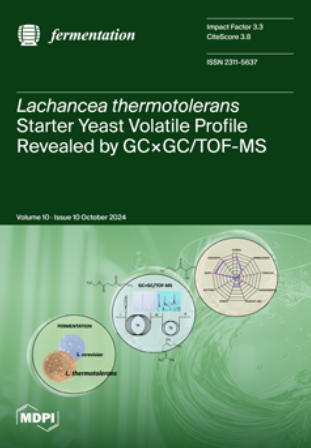使用高度专业化的生物催化剂在双相黑暗发酵中从农业工业资源中生产乳酸或生物氢和丁酸
IF 3.3
3区 农林科学
Q2 BIOTECHNOLOGY & APPLIED MICROBIOLOGY
引用次数: 0
摘要
本研究旨在研究使用含有乳酸菌(LAB)和乳酸氧化产氢菌(LO-HPB)的高度专业化细菌接种物,通过双相暗发酵从几种农用工业资源中生产乳酸或生物氢和丁酸盐的可行性。原料为果蔬废弃物、奶酪乳清、咖啡废水、龙舌兰酒调味汁和玉米加工废水,并在单发酵和共发酵中进行了测试。获得的结果表明,使用的生物催化剂能够进行双相乳酸发酵,在所有测试原料中产生高乳酸(13.1–36.4 g/L)、生物氢(0.2–7.5 NL H2/L原料,相当于0.3–1.7 mol H2/mol己糖)和丁酸(3.3–13.9 g/L)。为了进行比较,还对粗奶酪乳清和果蔬废弃物进行了一系列自发酵试验。与接种物辅助发酵相比,自发酵表现出降低的生物转化效率。短长度16S rRNA基因测序分析显示,LO-HPB是生物催化剂中的优势微生物群(86.0%),其次是乙酸菌(5.8%)和乳酸菌(5.7%)。不出所料,分子分析还显示,生物催化剂的微生物群落结构与自发酵进化的微生物群落存在显著差异。除了乳酸发酵和氧化外,生物催化剂还通过耗氧和底物水解辅助双相乳酸发酵。总的来说,这项研究可以为强大的接种物开发奠定基础,这在黑暗发酵领域具有特殊意义,并通过权衡方法提出了一种创新的农工业价值化生物工艺,为目标产品定制代谢途径。本文章由计算机程序翻译,如有差异,请以英文原文为准。
Use of a Highly Specialized Biocatalyst to Produce Lactate or Biohydrogen and Butyrate from Agro-Industrial Resources in a Dual-Phase Dark Fermentation
This study aimed at investigating the feasibility of using a highly specialized bacterial inoculum harboring lactic acid bacteria (LAB) and lactate-oxidizing, hydrogen-producing bacteria (LO-HPB) to produce either lactate or biohydrogen and butyrate from several agro-industrial resources via dual-phase dark fermentation. The feedstocks were fruit–vegetable waste, cheese whey, coffee wastewater, tequila vinasse, and maize processing wastewater, and were tested in both mono- and co-fermentation. The results obtained indicated that the biocatalyst used was able to perform a dual-phase lactate fermentation, producing high lactate (13.1–36.4 g/L), biohydrogen (0.2–7.5 NL H2/Lfeedstock, equivalent to 0.3–1.7 mol H2/mol hexose), and butyrate (3.3–13.9 g/L) with all the tested feedstocks. A series of self-fermentation tests were also performed with crude cheese whey and fruit–vegetable waste for comparison purposes. Compared to inoculum-aided fermentations, the self-fermentation exhibited a reduced bioconversion efficiency. Short-length 16S rRNA gene sequencing analysis showed that LO-HPB was the dominant microbial group (86.0%) in the biocatalyst, followed by acetic acid bacteria (5.8%) and LAB (5.7%). As expected, the molecular analysis also showed significant differences in the microbial community structure of the biocatalyst and those that evolved from self-fermentation. Besides lactate fermentation and oxidation, the biocatalyst also assisted the bi-phasic lactate fermentation via oxygen consumption, and apparently, via substrate hydrolysis. Overall, this study can lay the foundation for robust inoculum development, which is of special significance in the field of dark fermentation, and proposes an innovative bioprocess for agro-industrial valorization through a trade-off approach, tailoring the metabolic pathway to the target product(s).
求助全文
通过发布文献求助,成功后即可免费获取论文全文。
去求助
来源期刊

Fermentation-Basel
BIOTECHNOLOGY & APPLIED MICROBIOLOGY-
CiteScore
3.80
自引率
18.90%
发文量
594
审稿时长
7 weeks
期刊介绍:
Fermentation-Basel is an international open access journal published by MDPI, focusing on fermentation-related research, including new and emerging products, processes and technologies, such as biopharmaceuticals and biotech drugs. The journal enjoys a good reputation in the academic community and provides a high-impact forum for researchers in the field of bioengineering and applied microbiology.
 求助内容:
求助内容: 应助结果提醒方式:
应助结果提醒方式:


